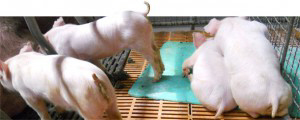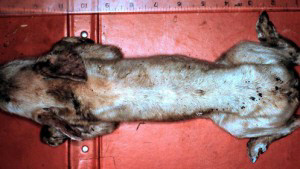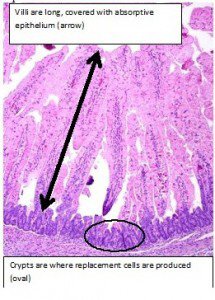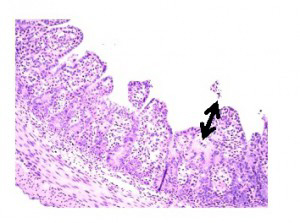



Looking for Ways to Get Relief from PED
As the result of its specific properties on intestinal health, butyrate may be a very valuable tool in the fight against the dramatic effects of porcine epidemic diarrhoea (PED) on the infected pig, report Maja Marien, DVM, PhD and Tim Goossens, PhD, Product Managers for Digestive Performance at Nutriad.Geographical Incidence
Porcine epidemic diarrhoea (PED) is caused by a coronavirus somewhat similar to that which causes transmissible gastroenteritis. The PED virus was first recognised in the UK in 1971 and has spread throughout most of Europe and Asia where it is in many countries considered to be endemic (AASV, 2013).
Severe outbreaks with high mortality are typically rare in Europe but are recently reported to be common in Asia. China has seen a large increase in outbreaks since 2010 which has been attributed to the emerging of new strains (Geiger et al., 2013).
It was not present in the US until spring 2013, when the first confirmation of the virus took place. In the meantime, the virus has emerged in Canada and the total number of US states with at least one confirmed case of PED has risen to 27.
Reports from Latin America and Asia indicate that the virus might be present there as well.
Pathogenesis and Clinical Signs
Pigs are the only known hosts of the PED virus. The virus is shed in the faeces and is usually transmitted orally. Most commonly, the introduction of infected pigs into susceptible farms causes outbreaks of PED within four to five days. Virus may also be introduced into a susceptible herd through contaminated personnel, equipment and other fomites (Pospischil et al., 2002).
After the recent outbreaks in the US and Canada, imported porcine blood and blood products are being investigated as to their possible role in introduction of the disease.
Clinical signs of PED may vary widely and are dependent on previous exposure and the immunological and endemic status of the farm, region or area affected (Geiger et al., 2013).
Acute outbreaks occur when the virus is first introduced into a susceptible (i.e. naïve) population (epidemic situation). The main clinical sign in all age groups is watery diarrhoea, vomiting and loss of appetite. Morbidity approaches 100 per cent. Infected piglets up to one week old die from dehydration after three to four days (mortality averages about 50 per cent). Older piglets recover in about one week.
Feeders, finishers and adult swine have diarrhoea, depression, anorexia and signs of abdominal pain. Outbreaks often start in these age groups. Although recovery usually follows, there may be some mortality (one to three per cent).
If introduced in herds where the virus is endemic, persistent diarrhoea is observed with lower morbidity in predominantly suckling and recently weaned pigs.

(Source: http://www.pig333.com/)

(Source: http://www.nadis.org.uk/)
The underlying cause for the clinical signs is that the virus replicates in enterocytes on villi of the small intestine and to a lesser degree in cryptal cells of both small intestine and colon. Viral replication subsequently causes degeneration and necrosis of enterocytes, resulting in loss of tissue fluid into the lumen and failure of the intestine to adequately absorb water. Diarrhoea follows and leads to dehydration and depletion of electrolytes.

(Source: http://nationalhogfarmer.com)

(Source: http://nationalhogfarmer.com)
Prevention and Treatment
To prevent infection, the number one focus point remains, as always, good biosecurity.
With highly contagious diseases such as PED, this is however not easy at all. If the virus is introduced, maternal antibodies via colostrum from previously exposed sows may protect neonates against oral infection until about four to 13 days of age (Song and Park, 2012).
Licensed PED vaccines are currently only available in South Korea, Japan and China. Immunity can also be induced via feedback of intestinal contents and faeces to sows and replacement gilts; however, so far immunity is not lifelong, herds can re-break. Furthermore, depending on local legislation, people applying this method may be violating law as transporting infected materials brings additional risk of spreading the disease.
Treatment focuses on supportive therapy to prevent dehydration (electrolytes, warmth) and if needed on the control of secondary infections.
Potential Benefits of Butyrate
Apart from the above mentioned approaches, producers are looking for other options to strengthen the animal’s defence and to help the pigs dealing with the negative consequences from the disease. Owing to its specific effects on enteric development and intestinal health, one of those options is butyrate.
Several studies have indicated that besides providing epithelial cells with energy, butyrate markedly enhances proliferation, differentiation and maturation of enterocytes in the small intestine and improves colonic barrier function (Wang et al., 2005; Manzanilla et al., 2006; Sengupta et al., 2006). Through its influence on gene expression and protein synthesis, butyrate speeds up intestinal mucosa maturation during the development or repair after injury (Kotunia et al., 2004; Guilloteau et al., 2010).
This protective and recovering effect of butyrate has been demonstrated in in-vivo challenge trials with micro-organisms (E. coli in piglets and C. perfringens in poultry) damaging the intestinal barrier like PED virus does. In the challenge trials, administration of butyrate was able to prevent to a great extent the negative effects of the intestinal challenges and allow for growth very close to the growth of uninfected animals (Bosi et al., 2009; Timbermont et al., 2010). Furthermore, butyrate modulates ion absorption and may alleviate the severity of the diarrhoea (Vidyasagar & Ramakrishna, 2002; Binder, 2010).
It is well known from literature and from field experience that the benefits of butyrate on gut development are most obvious in the youngest animals. Studies in neonatal and in weaned piglets show that the ingestion of butyrate results in improved performance, which is further improved if butyrate is fed sooner rather than later post-birth (Kotunia et al., 2004; Mazzoni et al., 2008; Le Gall et al., 2009). This feature can be very valuable in the case of PED as the disease has the most severe impact on the young animals.
More recent research at the University of Taiwan looked into survival of PED-infected newborn piglets. These piglets were separated from the sows after one week, to evaluate interventions aiming to increase survival. While only 20 per cent of the infected control piglets survived the second week, livability was documented to be strongly increased to 70 per cent in the group that received a liquid creep feed including 1.5kg per tonne of ADIMIX®30 Coated. These results demonstrate that ADIMIX supplementation in PED affected piglets helps them to cope better with the infection.
Using the Right Product
Since the virus damages intestinal cells in the small intestine and in the colon, it is crucial that butyrate is able to reach these areas. Butyrate can only arrive in the lower luminal parts of the intestinal tract when it is protected from metabolisation in the stomach and is gradually released in the distal regions of the intestine. The most efficient way to achieve this is by administering a protected butyrate with precision delivery capacity such as ADIMIX 30 Coated.

Different coated butyrate products are available for use in animal production. They come, however, in many different shapes and forms. One should make a clear distinction between high-quality coatings that result in optimal protection and precision delivery of butyrate and coatings that are solely applied to cover the distinct butyrate smell.
In recent research done at the University of Illinois (Song et al., 2013), the importance of a high-quality coating was demonstrated. Weanling pigs were randomly allotted to three dietary treatments (six replicate pigs per treatment):
- control diet
- control diet + 4kg per tonne of a smell-coated butyrate (50 per cent Na-butyrate)
- control diet + 4kg per tonneT of a precision-delivery butyrate (ADIMIX 30 Coated, 30 per cent Na-butyrate).
Pigs were euthanised and the concentration of butyrate was analysed in samples from different parts of the intestinal tract.

Weanling pigs fed ADIMIX 30 Coated had significantly higher (P<0.05) concentrations of butyrate in the jejunum and ileum than either the control group or the group fed the smell coated butyrate.
It could therefore be concluded that administration of high-quality protected butyrate (ADIMIX 30 Coated), in spite of lower percentage of Na-butyrate (30 per cent), was effective in delivering butyrate to the lower intestinal tract of pigs, whereas supplementation of the more concentrated (50 per cent) but less protected butyrate (smell-coated) was not.
Summary
In conclusion, thanks to its specific properties on intestinal health, butyrate may be a very valuable tool in the fight against the dramatic effects of PED on the infected pig.
However, to unlock the full potential of butyrate, it is crucial to assure its delivery in the right area. When applying protected butyrates in animal production, it is of great importance to distinguish between different types of coated products, as their in-vivo efficacy will greatly differ due to their different delivery profile.
The results demonstrate that ADIMIX 30 Coated is able to deliver butyrate to the areas most affected by PED.
March 2015








